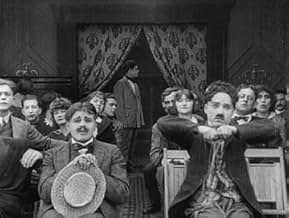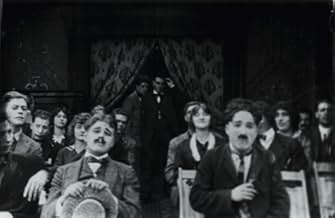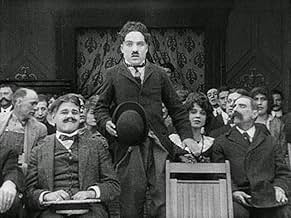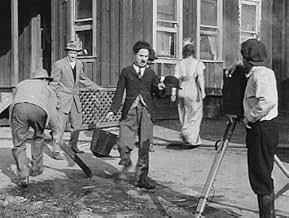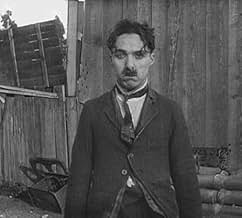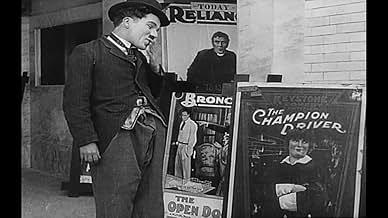VALUTAZIONE IMDb
5,6/10
1812
LA TUA VALUTAZIONE
Aggiungi una trama nella tua linguaCharlie attempts to meet his favorite movie actress at the Keystone Studio, but does not win friends there.Charlie attempts to meet his favorite movie actress at the Keystone Studio, but does not win friends there.Charlie attempts to meet his favorite movie actress at the Keystone Studio, but does not win friends there.
- Regia
- Sceneggiatura
- Star
Dan Albert
- Audience Member
- (non citato nei titoli originali)
Hampton Del Ruth
- Lead Actor
- (non citato nei titoli originali)
Minta Durfee
- Self
- (non citato nei titoli originali)
- …
Billy Gilbert
- Theatre Usher
- (non citato nei titoli originali)
William Hauber
- Audience Member
- (non citato nei titoli originali)
Bert Hunn
- Audience Member
- (non citato nei titoli originali)
George Jeske
- Prop Boy in White Shirt
- (non citato nei titoli originali)
Edgar Kennedy
- Director
- (non citato nei titoli originali)
Sadie Lampe
- Audience Member
- (non citato nei titoli originali)
Henry Lehrman
- Self
- (non citato nei titoli originali)
Hank Mann
- Prop Boy in Overalls
- (non citato nei titoli originali)
Harry McCoy
- Fireman
- (non citato nei titoli originali)
- …
George Nichols
- Older Actor on Screen
- (non citato nei titoli originali)
Recensioni in evidenza
Charles Chaplin plays an overly infatuated film fan who decides to visit a movie theatre after seeing a gorgeous actress on the poster. In theatre, he causes quite a havoc before he gets thrown out. Afterward, he manages to get inside the movie studio where he sees the girl from the poster and movie. Well, you guessed it, more havoc is caused.
The theme of a fan falling in love with a starlet is interesting. The plot is easy to follow, even though some scenes seem quite randomly put together. The most interesting part to me was of course the look inside The Keystone Studios and to see how the films were made back in the day. Chaplin's Tramp was still just a trouble maker, but perhaps here some of the more recognizable traits are becoming visible.
Chaotic but still amusing movie. One of the best from the early works of Charles Chaplin.
If anyone has a question about what the title means then it is a play with the term "stage door Johnnie" which was used to describe people who hang out near the theatres in hopes of meeting actors or even land a job in the theatre.
The theme of a fan falling in love with a starlet is interesting. The plot is easy to follow, even though some scenes seem quite randomly put together. The most interesting part to me was of course the look inside The Keystone Studios and to see how the films were made back in the day. Chaplin's Tramp was still just a trouble maker, but perhaps here some of the more recognizable traits are becoming visible.
Chaotic but still amusing movie. One of the best from the early works of Charles Chaplin.
If anyone has a question about what the title means then it is a play with the term "stage door Johnnie" which was used to describe people who hang out near the theatres in hopes of meeting actors or even land a job in the theatre.
7tavm
Just watched on the Internet Archive site 8 minutes of what this site states was a 15 minute short made by Mack Sennett's Keystone Studios. It stars Charlie Chaplin in another of his early appearances in which he's at that studio, as a civilian in his Tramp costume, wreaking havoc. If I didn't read the synopsis here beforehand, I would have been partly confused as to what was going on but because of that, I laughed at the part where he came to the "rescue" of his lady crush when she was being "attacked" and when he used the gun to kill her "attacker". Also, was that the first time that gun was used to light a cigarette? Was marred a bit by blurry titles and, once again, missing beginning context. Still, I was quite fascinated by what I saw of A Film Johnnie. Update-6/14/11: I just watched the entire thing on YouTube with the original Keystone titles intact. It's now a bit funnier so I'm now upping the rating from 5 to 7.
Film Johnnie, A (1914)
** (out of 4)
Charles Chaplin plays a film buff who goes to Keystone Studios to meet his favorite stars, which he does but at the same time he doesn't find himself welcomed after a while. Roscoe 'Fatty' Arbuckle, Virginia Kirtley, Mabel Normand and Ford Sterling are among the stars seen at the studio and while this it's fun to see all these stars together I wouldn't go further by calling this a good movie. Chaplin is quite animated here as he finds himself getting into one mess after another, which eventually leads to his setting a set on fire. Some historians seem to think that this movie was a way for the studio to display their feelings towards Chaplin. It was well known that he was causing trouble with his attitude even this early in his career so historians believe the annoying character here is the studio showing him as he was. I'm not sure how true this is but it's an interesting theory.
** (out of 4)
Charles Chaplin plays a film buff who goes to Keystone Studios to meet his favorite stars, which he does but at the same time he doesn't find himself welcomed after a while. Roscoe 'Fatty' Arbuckle, Virginia Kirtley, Mabel Normand and Ford Sterling are among the stars seen at the studio and while this it's fun to see all these stars together I wouldn't go further by calling this a good movie. Chaplin is quite animated here as he finds himself getting into one mess after another, which eventually leads to his setting a set on fire. Some historians seem to think that this movie was a way for the studio to display their feelings towards Chaplin. It was well known that he was causing trouble with his attitude even this early in his career so historians believe the annoying character here is the studio showing him as he was. I'm not sure how true this is but it's an interesting theory.
Am a big fan of Charlie Chaplin, have been for over a decade now. Many films and shorts of his are very good to masterpiece, and like many others consider him a comedy genius and one of film's most important and influential directors.
He did do better than 'A Film Johnnie', still made very early on in his career where he was still finding his feet and not fully formed what he became famous for. Can understand why the Keystone period suffered from not being as best remembered or highly remembered than his later efforts, but they are mainly decent and important in their own right. 'A Film Johnnie' is a long way from a career high, but has a lot of nice things about it.
'A Film Johnnie' is not as hilarious, charming or touching as his later work and some other shorts in the same period. The story is flimsy and the production values not as audacious. Occasionally, things feel a little scrappy and confused.
For someone who was still relatively new to the film industry and had literally just moved on from their stage background, 'A Film Johnnie' is not bad at all.
While not audacious, the film hardly looks ugly, is more than competently directed and is appealingly played. Chaplin looks comfortable for so early on and shows his stage expertise while opening it up that it doesn't become stagy or repetitive shtick. The Tramp did become more likeable later but again he was still evolving.
Although the humour, charm and emotion was done even better and became more refined later, 'A Film Johnnie' is humorous, sweet and easy to like, though the emotion is not quite there. It moves quickly and doesn't feel too long or short.
Overall, far from one of Chaplin's best but pretty good and perhaps one of his better efforts from the early Keystone period. 7/10 Bethany Cox
He did do better than 'A Film Johnnie', still made very early on in his career where he was still finding his feet and not fully formed what he became famous for. Can understand why the Keystone period suffered from not being as best remembered or highly remembered than his later efforts, but they are mainly decent and important in their own right. 'A Film Johnnie' is a long way from a career high, but has a lot of nice things about it.
'A Film Johnnie' is not as hilarious, charming or touching as his later work and some other shorts in the same period. The story is flimsy and the production values not as audacious. Occasionally, things feel a little scrappy and confused.
For someone who was still relatively new to the film industry and had literally just moved on from their stage background, 'A Film Johnnie' is not bad at all.
While not audacious, the film hardly looks ugly, is more than competently directed and is appealingly played. Chaplin looks comfortable for so early on and shows his stage expertise while opening it up that it doesn't become stagy or repetitive shtick. The Tramp did become more likeable later but again he was still evolving.
Although the humour, charm and emotion was done even better and became more refined later, 'A Film Johnnie' is humorous, sweet and easy to like, though the emotion is not quite there. It moves quickly and doesn't feel too long or short.
Overall, far from one of Chaplin's best but pretty good and perhaps one of his better efforts from the early Keystone period. 7/10 Bethany Cox
The film was produced in March 1914, during the post-Mabel's Strange Predicament period when Mabel Normand was still refusing to work with Chaplin (Mack Sennett's autobiography). Sennett, however, managed to get Mabel into the film by displaying a poster depicting her as a champion racing driver. Chaplin is meant to fall in love with her image, but note that he takes the opportunity to disrespect the Keystone Girl by mocking her dirty, oily face. This is probably the film where new-boy Chaplin later says he had an angry confrontation with director 'Pops' Nichols. Long-serving Popsie almost had a seizure when the ranting Charlie told the old guy he knew nothing about directing pictures!
In any event, the warring pair managed to finish the movie, which has a weak story-line, but gives Sennett an advertising opportunity for Keystone. Charlie goes on to create uproar in the picture house when he sits on Mrs Arbuckle's lap, and overdoes the emotional stakes when Keystone's Peggy Pearce appears on screen.
Having been thrown out of the picture-house, Charlie decides to get down to the Keystone studios and meet the stars. He appears at Keystone as car loads of the company arrive, including Fatty Arbuckle from who he begs a dime. Minta Arbuckle merely laughs at the tramp- like Charlie, who she later described as being dirty and smelly. Incidentally the studio is not the real lot, and the set appears to be among some very upper-crust accommodation indeed. It is in fact the swanky Bryson Apartments on Wilshire Boulevard! After being told 'No bums here' by director Edgar Kennedy, Charlie forces his way into the studio, and who should he see on the set but the Keystone girl to die for – Peggy Pearce. Following attempts to force himself on Peggy and interfere with the action, Charlie acquires a revolver and begins to shoot up the set, sending the cast diving for cover. Our tramp now leaves the studio, slams the door behind him, and gives the aging doorman a swift kick.
A house fire occurring in the vicinity, sends the cast racing off in the Keystone cars, in order to obtain some 'atmosphere' for their film. For some unexplained reason, crazy Charlie is already on his way to the scene, and running down the middle of Wilshire Boulevard (or is it Broadway?). When Charlie reaches the fire (which appears to be in dusty old Edendale) he finds the film crew already setting up for a scene in which Peggy Pearce is being roughed up. The gallant tramp intervenes and incurs the wrath of the studio men, one of whom tries to brain him with a plank. When Charlie attempts to abduct Peggy, she responds by giving the tramp a good whipping.
According to Sennett, Chaplin had no designs on any of the Keystone starlets, and no success with women in general during 1914. He was right about the second part, but Charlie made amorous advances to both Peggy Pearce and Mabel Normand. Both were eventually to reject the 'lovable genius of a problem child' (as Mary Pickford called Chaplin). Several of Chaplin's sworn enemies are in this picture, including Pathe Lehrman and Pops Nichols. Everyone made representations to Sennett that Chaplin was impossible to work with, but Lehrman also said that Chaplin was in love with Mabel, and that Mabel was having various affairs (including, somewhat later, with Valentino). How did Sennett respond? He took the Tramp and the Jazz Babe out to dinner every night – what better way of keeping an eye on the recalcitrant pair.
In any event, the warring pair managed to finish the movie, which has a weak story-line, but gives Sennett an advertising opportunity for Keystone. Charlie goes on to create uproar in the picture house when he sits on Mrs Arbuckle's lap, and overdoes the emotional stakes when Keystone's Peggy Pearce appears on screen.
Having been thrown out of the picture-house, Charlie decides to get down to the Keystone studios and meet the stars. He appears at Keystone as car loads of the company arrive, including Fatty Arbuckle from who he begs a dime. Minta Arbuckle merely laughs at the tramp- like Charlie, who she later described as being dirty and smelly. Incidentally the studio is not the real lot, and the set appears to be among some very upper-crust accommodation indeed. It is in fact the swanky Bryson Apartments on Wilshire Boulevard! After being told 'No bums here' by director Edgar Kennedy, Charlie forces his way into the studio, and who should he see on the set but the Keystone girl to die for – Peggy Pearce. Following attempts to force himself on Peggy and interfere with the action, Charlie acquires a revolver and begins to shoot up the set, sending the cast diving for cover. Our tramp now leaves the studio, slams the door behind him, and gives the aging doorman a swift kick.
A house fire occurring in the vicinity, sends the cast racing off in the Keystone cars, in order to obtain some 'atmosphere' for their film. For some unexplained reason, crazy Charlie is already on his way to the scene, and running down the middle of Wilshire Boulevard (or is it Broadway?). When Charlie reaches the fire (which appears to be in dusty old Edendale) he finds the film crew already setting up for a scene in which Peggy Pearce is being roughed up. The gallant tramp intervenes and incurs the wrath of the studio men, one of whom tries to brain him with a plank. When Charlie attempts to abduct Peggy, she responds by giving the tramp a good whipping.
According to Sennett, Chaplin had no designs on any of the Keystone starlets, and no success with women in general during 1914. He was right about the second part, but Charlie made amorous advances to both Peggy Pearce and Mabel Normand. Both were eventually to reject the 'lovable genius of a problem child' (as Mary Pickford called Chaplin). Several of Chaplin's sworn enemies are in this picture, including Pathe Lehrman and Pops Nichols. Everyone made representations to Sennett that Chaplin was impossible to work with, but Lehrman also said that Chaplin was in love with Mabel, and that Mabel was having various affairs (including, somewhat later, with Valentino). How did Sennett respond? He took the Tramp and the Jazz Babe out to dinner every night – what better way of keeping an eye on the recalcitrant pair.
Lo sapevi?
- QuizAlthough some sources credit Mack Sennett with playing himself, the film director, the role is actually played by Edgar Kennedy--who, besides being a comic actor, was also a respected director.
- BlooperMembers of the audience behind Charlie Chaplin change - for example, Minta Durfee is sitting behind Chaplin in some shots, but a different actress is seated behind him in others.
- Versioni alternative1930s reissue version, entitled Film Johnny, (released on DVD) omits the opening sequence in the movie theater.
- ConnessioniFeatured in Crazy Days (1962)
I più visti
Accedi per valutare e creare un elenco di titoli salvati per ottenere consigli personalizzati
Dettagli
- Data di uscita
- Paese di origine
- Siti ufficiali
- Lingue
- Celebre anche come
- A Film Johnnie
- Luoghi delle riprese
- Bryson Apartments, 2701 Wilshire Blvd., Los Angeles, California, Stati Uniti(Apartment Building)
- Azienda produttrice
- Vedi altri crediti dell’azienda su IMDbPro
- Tempo di esecuzione
- 15min
- Colore
- Mix di suoni
- Proporzioni
- 1.33 : 1
Contribuisci a questa pagina
Suggerisci una modifica o aggiungi i contenuti mancanti

